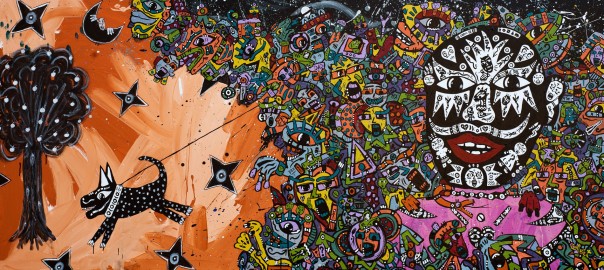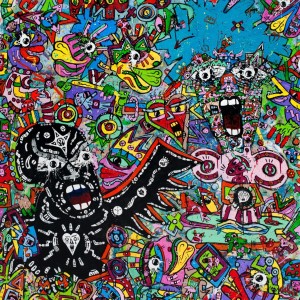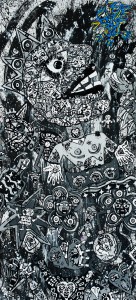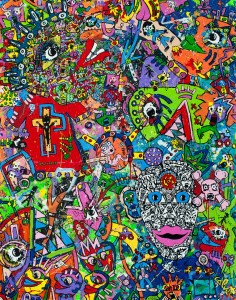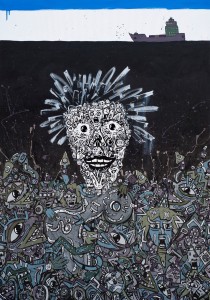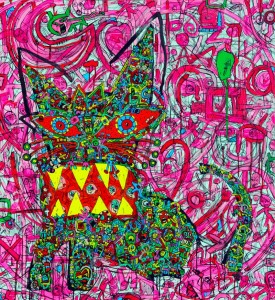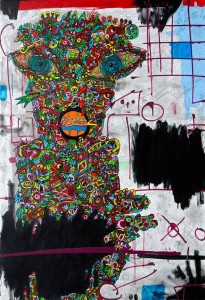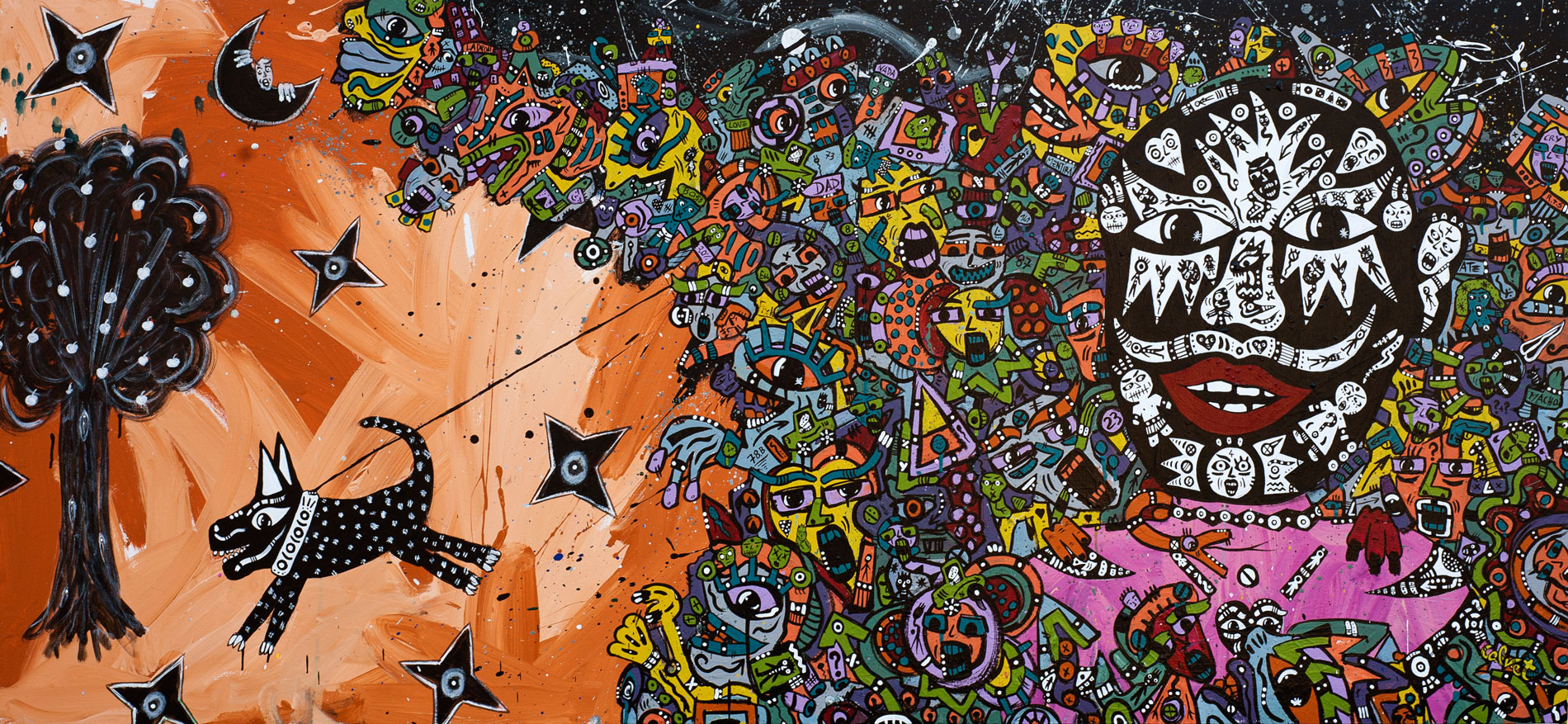A film screening presented by Alison Poltock at the Royal Academy, during the East End Film Festival last October, opened my eyes to the life and work of Jean-Marc Calvet. Calvet The Movie, directed by Dominic Allan, was released in 2011. Allan chanced upon this extraordinary Frenchman and his intense artistic output in Nicaragua in 2004.
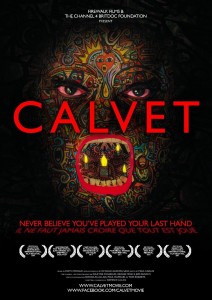 They met as Calvet was emerging from the most chaotic and suicidal period in his life. He was 2 years into a cathartic phase, painting furiously, spewing out the devils in his head onto walls, then paper and canvas. As they got to know each other Allan suggested making a movie about Calvet and the emergence of his art, vowing not to interfere with his protagonist’s story. The result is a torrent of powerful confessional footage captured on a small hand held camera.
They met as Calvet was emerging from the most chaotic and suicidal period in his life. He was 2 years into a cathartic phase, painting furiously, spewing out the devils in his head onto walls, then paper and canvas. As they got to know each other Allan suggested making a movie about Calvet and the emergence of his art, vowing not to interfere with his protagonist’s story. The result is a torrent of powerful confessional footage captured on a small hand held camera.
The manner in which Allan’s film is shot creates an immediacy and intimacy for the viewer which is at times uncomfortable. This is a transformational story, about hate and love, self-esteem and its complete absence, destruction, addiction and explosive creativity. It’s about darkness and isolation and it’s also about light, redemption and most of all colour.
The film is narrated with unflinching honesty by the man himself. We glimpse his disturbed childhood in the South of France, in an area famed for its outstanding natural beauty and rich artistic heritage. For locals like Calvet, born in Nice in 1965, it is also known for its louche underbelly, the prostitution, drugs, and the corruption. This is a world where a cast of Mafioso characters blends somewhat seamlessly into the glamour of the Cannes film festival, the glistening casinos, super yachts and Hollywood celebrities.
We visit the early breakdown of Calvet’s family relationships, an adolescence which becomes filled with self-loathing, anaesthetised by alcohol and drugs, tainted by violence, sexual and emotional abuse. The young Calvet is already battling between good and bad, love and hate, words which later spring, sometimes literally, from his large scale artworks.
Calvet finds himself first in the French Foreign Legion, then in the police force, from where he falls all too easily back into a familiar dark side. On night duty he hooks up with a world and a language which he understands fluently. He hovers precariously on both sides of the law, a bent cop. This duality between good and bad is the leitmotif which pervades both Calvet’s life (within the film) and his work. He then becomes a bodyguard, working at first with famous actors, shadowing them through the film festival, eventually falling in with a mysterious client via an offer he can’t refuse.
He spirits himself away to Miami, expecting riches and the high life, instead sinking into the darkest mileu with a boss who is clearly a mobster. He has left everything behind including his identity and most importantly his young son – abandoned – a fact which he declares as his most abject mistake ever.
He escapes Florida for Central America in the most dramatic fashion, swapping one hell for another, far more potent: himself. “I had to pay for the past. I had to make myself suffer.” Plunging violently into drug and drink fuelled self-destruction he speeds, literally, to the very bottom. Emaciated, gripped by paranoia, he beckons death’s releasing embrace. Mentally and physically, he locks himself away. Months go by in a psychotic blur, destruction reigns: “I broke everything in my life.”
And then, in his darkest moment, colour touches him in a primeval way, electrifying him back to life. Engulfed by delusions, hallucinating, he is hunting down the devils in his head. He falls upon some glinting shadows hiding under his stairs. Terrified and deranged, he prises open what turns out to be old paint cans. As he punches into the coagulating mass within, it sprays into his face in an explosion of colour. Scraping it off, he spews the dense liquid onto the walls of his self-made prison. “All my hate had come out. It came out onto the wall. And everything that was here (inside) was on the wall…. and I understood this language.”
This is no subtle creative awakening, no philosophical evolution – this is a visceral, violent outpouring, an excorcism. A distressed rainbow erupts from his hands, his whole body and mind, unstoppable, compulsive. He proceeds to daub the entire house, running out of paint and using anything he can lay his hands on: stale pizza, old drinks, the very dirt off the floor (see the small trio of film stills further down this page).
Calvet’s merciless and at times brutally graphic narrative is delivered in his native French and the film is subtitled with the same sharp shock statements. At a central point this biographical narrative morphs into a search for his abandoned child. His son must be found. By now Calvet has become a successful painter and we follow his journey back to France where he drives around tracing and eventually finding his truth. He is lucid and realistic, at pains not to impose himself – ruthless in the knowledge that he lost his path throwing precious relationships, and his entire self, away.
Creativity gave Calvet his first key on the road back to sanity. Stepping up to meet the audience at the end of the screening for the Royal Academy’s Q&A, he acknowledges that the film gave him the second. From a man unable at first to face himself in a mirror, he has learnt to let go of every secret. At a pivotal point in the film, sensing his own cowardice, he seizes on the presence of the camera as an all-seeing, unforgiving witness – on film he can no longer back out from his mission. He shares this fact with an engaging humour – “I am just a man after all” – and no apparent trace of pity.
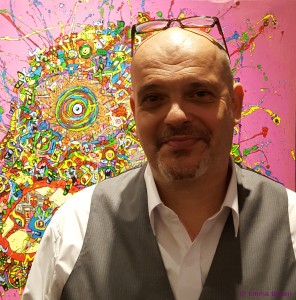 Given the venue, the questions focus primarily on his art. We are also invited to the private view of Calvet’s show, due to open the following night at the French Art Studio in West London. I took up this unexpected opportunity to view recent paintings, which turned out to be every bit as compelling as the film. From a chance attendance at the screening, then the private view, I found myself interviewing Calvet the following day.
Given the venue, the questions focus primarily on his art. We are also invited to the private view of Calvet’s show, due to open the following night at the French Art Studio in West London. I took up this unexpected opportunity to view recent paintings, which turned out to be every bit as compelling as the film. From a chance attendance at the screening, then the private view, I found myself interviewing Calvet the following day.
My prime interest was the link between creativity and mental health. A few years ago I launched a fund and awareness raising campaign called The Fine Line Project. Its roots were in music, drawing on a pool of friends and artists who understood the meaning of that fine line. We almost all, at some time in our lives, tread a precarious path between feeling settled and unsettled mentally. For some, like Calvet, this can spiral way out of control. It isn’t necessarily to do with drink or drugs although they undeniably play their part for many. The Fine Line Project was all about talking and sharing mental health issues of every kind, with a strong focus on creativity. As other work overtook my life, related blog posts and fundraisers had dwindled and come to a halt. Seeing Calvet and listening to him share his story and his art reopened that door. I saw this as an opportunity to weave The Fine Line Project, via the common thread of creativity, into my current work with Armadillo Central. Everything overlaps. As does Calvet’s life and his art of course.
He was generous with his time and happy to share more. I had a list of questions which fell slightly by the wayside, hijacked by his fascinatingly long and compulsively detailed replies. I wanted to focus my enquiries on the art and its interface with mental health. I started with the labels commonly applied to art and other creative work and I wanted to know if he’d ever learnt to draw or to ‘see’ in the artistic sense? He used to write and listen to music, which is still a big influence. One of his recent works (see above) was even inspired by and named after Lazarus, the late David Bowie’s last album. But there were no early drawings, no interest at home or at school, nor had he ever created any art before.
Calvet’s lack of prior interest or formal training is compensated for by his highly expressive paintings, which have evolved from their original raw state, as described in the film. Although the French expression ‘art brut’ seems to perfectly describe his work, he sees it not as ‘outsider art’, a label which some have applied, but as ‘insider art’ – which seems far more resonant – a kind of introspection through the creative process. “I am in a perpetual state of diving into myself, right inside.”
The urge to paint comes daily, a form of therapy which more recently he is keen to share with others. “I feel that I absolutely have to paint or draw every single day. It is the most powerful instrument, helping me to explore my childhood and other life stories. It deep-cleanses my paranoia and dark thoughts. My ‘demons’ haven’t disappeared but they no longer dominate my life. They used to frighten me, control me and I used to try and obliterate them through drink and drugs. Now I’m no longer scared to go in and take a look, to bring things out. Then I can put them back again. I can look at my history and my ‘demons’, I can visit them, use them. I can go into the past but I don’t have to stay there. I can pour my emotional reactions into the paint, get them out onto the surface.”
“From a life in which I broke everything I now have a tool for rebuilding myself and for sharing that process with others. This is where I am now. The dialogue is always open.” This is borne out by Calvet’s fast paced manner of talking, a stream of consciousness which flows until interrupted, in response to each question. “I wasted so much time and now I realise I might not have that much time left. I want to use every minute. I have another child now (in case you’re wondering, Calvet was re-united with his son, but you should watch the film to see how) and she is only 5, I want to spend as much time as I can with her, see her grow up.”
On the subject of colour, which he uses lavishly, he explains his lack of interest in the theory, the colour wheel and the mix of colours. “My decisions are not entirely conscious – I use mainly acrylics, the colour spills out of the container and I apply it. But I have moved on from ‘vomiting agua negra’ (the bile of his past life) and I now look for more balance. At the same time my artwork has progressed from being just for me, a cathartic expression, into something more therapeutic to share with others. I have found a complete freedom and I always had that – it just came out, initially thrown out – but there is some control in there now. I look at the whole picture and I look for balance.”
From total self-absorption, Calvet is largely transformed, although he is keen to point out that he and his work are constantly in progress, never static. Every day he gets up with the urge to move. What matters now is ‘the now’, as well as hopes for the future but without looking too far forwards, and what matters most is communicating, both with his inner self through his painting and with others. “It’s not so much about me and for me anymore, it’s about sharing. My artwork isn’t created for others but it’s not just for myself anymore.”
Calvet’s art is packed full of punches, laced with dark overtones and gloriously childlike highlights, with shades of street art, graffiti and bucket loads of cred. The paintings fizz with Smartie-like colours. They are densely populated by mouths and lips which are in turn screaming, howling, snarling, smiling and sometimes even seductive. Eyes pop out of every image, filled with violence, anger, terror, shock and also kindness and humour. In the film he talks of his son’s eyes appearing everywhere, haunting his thoughts and dreams. We also sense Calvet’s demons’ eyes, never far away but now restrained, contained by the condensed web of lines and colours that crisscross virtually every centimetre of every canvas. Eyes have long been charged with various symbolic meanings in art but one senses that Calvet’s are straight out of his head and heart, visual cues to a multitude of emotions, windows to his soul.
The titles give some indication of the inspiration and messages in different paintings but ultimately it is up to the viewer to decide. Not that Calvet is in any way unwilling to discuss the various works. If you chance upon him at a show, he is happy to talk, as I found.
Go see some of his multi-coloured work alongside some dense swathes of powerful black and white graphics in his forthcoming shows:
In England, see selected works this weekend at the London Art Fair, from the 18th to the 22nd of January, on French Art Studio’s stand G11.
Other paintings will be exhibited in the Singapore Contemporary Art Show with the Art Garrett Gallery (SAGG), Booth D12, between the 19th and the 22nd of January.
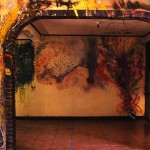

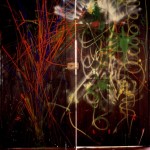 From the 16th February to the 2nd of March Calvet will be in New Zealand. He plans to use the compelling story of his transformation from addict to artist as a way to connect with at-risk young people. New Zealand has the highest youth suicide rate in the OECD. Young Maori men, in particular, kill themselves at a higher rate than any other group. This tour is designed to reach as many vulnerable young people as possible, a remit which fits neatly into The Fine Line Project’s ethos.
From the 16th February to the 2nd of March Calvet will be in New Zealand. He plans to use the compelling story of his transformation from addict to artist as a way to connect with at-risk young people. New Zealand has the highest youth suicide rate in the OECD. Young Maori men, in particular, kill themselves at a higher rate than any other group. This tour is designed to reach as many vulnerable young people as possible, a remit which fits neatly into The Fine Line Project’s ethos.
Wherever you are, watch the movie if you can. Prepare for a painful and uplifting ride, a complete exposé of that fine line through the words and images of one tremendously creative and communicative man.
Find out more about Jean-Marc Calvet’s work, the film and future projects on his website.
»Je peins par nécessité… sans penser, une espèce d’automatisme libre. Je laisse mon inconscient diriger ma main. Je cultive mes obsessions, me sers de mes démons, de mes fantômes pour en tirer une énergie créatrice. Je crois qu’un artiste est avant tout une antenne, un récepteur d’émotions, un passage dans différents mondes.
Dans ma peinture, chaque personnage est rempli d’histoires, de créatures, c’est un mouvement permanent de mort, d’amour, de sexe…de vie tout simplement.
Nous sommes faits de détails. Notre vie est rythmée par eux …sans eux nous n’existerions pas. On deviendrait transparent.
Au-dehors nous ne sommes que des mots, des paroles, à l’intérieur nous sommes couleurs… »
“I paint by necessity… without thought, some form of liberated automatism. I allow my unconscious mind to guide my hand. I cultivate my obsessions by making use of my demons and my ghosts to pull a creative energy from them. An artist is above all an antennae – an emotional receptor opening a passage into different worlds.
Each character in my paintings is filled with stories and creatures, giving life to a constant movement of death, love, sex… of life to put it simply.
We are all made up of details. Our life is constructed by them and in their absence we would not exist. We would become transparent.
On the surface, we are only words, expressions – inside we are colours.”
“Never believe you’ve played your last hand, never believe it’s too late, that things will never work out, even when you’re right at the bottom, no…”
“Il ne faut jamais croire que tout est joué…”
With thanks to Christine Jeanquier from Visit Artemisia for organising the interview and pictures, and to Jean-Marc Calvet, bien sûr, for sharing his story!
© Text: Emma Boden, 2017
© Images: Jean-Marc Calvet, except portrait by Emma Boden, 2016

